Like many places in Taiwan, Shanhua (善化) has had more than one name in its history. The first recorded was Bakaloan, a toponym used by the local Siraya indigenous people, and written 目加溜灣 by Holo-speaking Han settlers.
The Dutch East India Company in 1635 seized this corner of what’s now Tainan and endeavored to Christianize the inhabitants. After the Dutch were thrown out, the Kingdom of Dongning — the statelet established by Zheng Chenggong (鄭成功, also known as Koxinga ) and his band of Ming-dynasty loyalists — decreed that the settlement would be known as Shanhua. However, when Taiwan became part of the Qing Empire, the place name was changed to Wanlishe (灣裡社).
PROMOTING LITERACY
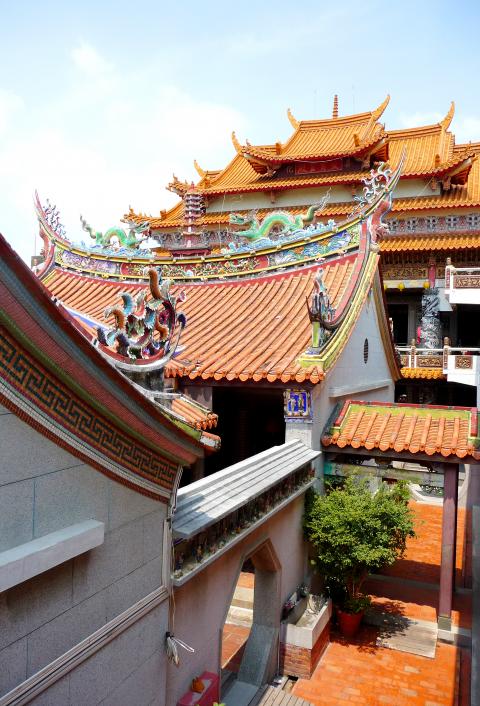
photo by Steven Crook
One man who lived here for a major part of the Dongning era is now revered as a pioneer of classical Chinese education in Taiwan. Shen Kuang-wen (沈光文) was born in China’s Zhejiang Province in 1612, but after the collapse of the Ming dynasty in 1644 he was forced to flee southward. After living for a while in poverty, he sailed to Taiwan a few months after Zheng Chenggong’s death. Hagiographies that have him arriving in Taiwan as early as 1649 have been shown to be wrong.
Shen’s efforts to promote literacy and Han civilization have earned him a place on the altar inside Shanhua’s most historic place of worship, Qingan Temple (慶安宮). The temple stands on the town’s busiest thoroughfare, right where — so it’s said — a Protestant church existed during the Dutch period. This site hosted a Confucius Temple at the beginning of the 18th century, then a shrine dedicated to Wenchang Dijun (文昌帝君), a god of culture and literature and the patron deity of those about to sit academic examinations.
That structure was wrecked in an earthquake in 1861, and the name Qingan Temple first appeared four years later when its replacement was completed. The principal deity nowadays is Mazu (媽祖). In the hall behind her, Guan Yu (關羽) occupies the central position.
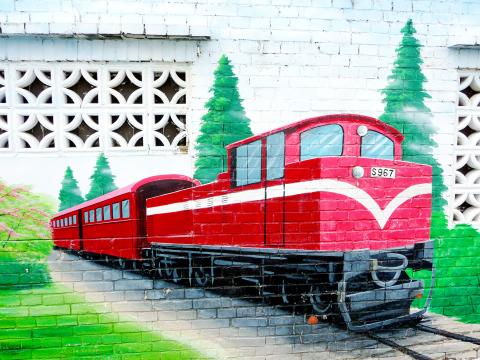
photo by Steven Crook
In front of Guan Yu, there are five soot-covered non-identical effigies of Wenchang Dijun. On the left, and slightly closer to those offering incense, another and somewhat less begrimed statuette represents Shen.
There are a couple of other reminders of the scholar elsewhere in the town. Shanhua Junior High School has a Kuang-wen Building (光文樓). Just north of Shanhua Taiwan Railway Administration Station, and clearly visible from trains, the Shen Kuang-wen Memorial (沈光文紀念碑) was dedicated in 1978. It’s believed Shen, who died in 1688, was buried hereabouts.
SUGAR INDUSTRY
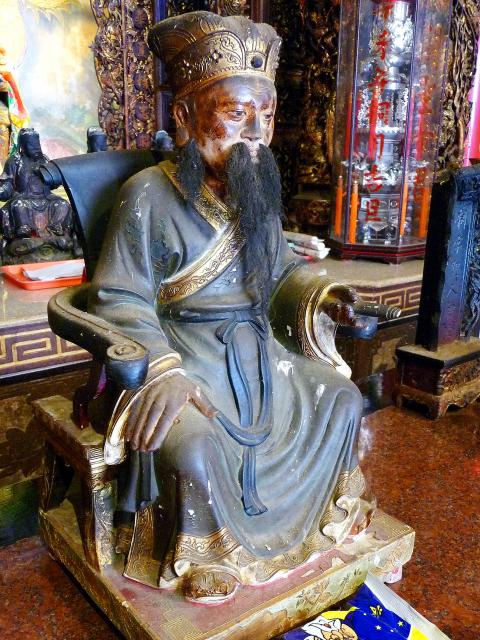
photo by Steven Crook
Even before Shen’s arrival in Shanhua, sugar had emerged as an important part of the local economy. The Dutch incentivized farmers to grow sugarcane because the commodity fetched a good price in Japan.
Sugar remained a key cash crop after the Europeans left, but physical remnants of the industry that existed before the Japanese colonial period are few and far between. Earlier this year, however, Tainan City Government’s Cultural Affairs Bureau announced an important discovery in Shanhua. During excavations ahead of a house construction, a set of six “stoves” used to produce sugar more than 150 years ago was found. Whether they will be preserved in situ or moved elsewhere has yet to be decided.
In 1946, when the incoming Chinese Nationalist Party (KMT) government created Taiwan Sugar Corp (TSC) to take control of the island’s sugar industry, Taiwan had 42 sugar factories and refineries. Several of them had sustained damage during World War II; the US Air Force targeted sugar-industry sites because they supplied ethanol to the Japanese military. Before the war, Taiwan was the world’s no. 4 source of sugar, and cane plantations covered a fifth of the island’s farmland. In the early 1950s, sugar exports accounted for 73.6 percent of the country’s foreign-currency earnings.
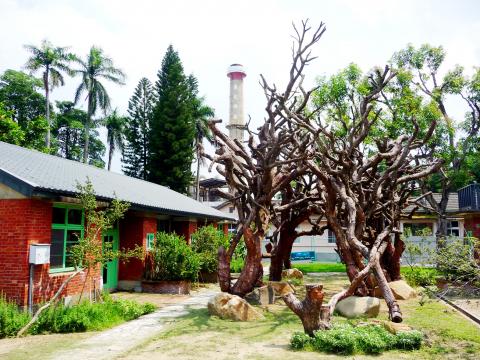
photo by Steven Crook
TSC even had its own railway network. A few remnants of the narrow-gauge branch lines that use to criss-cross the industry’s heartlands can be found beside the roads that approach Shanhua Sugar Factory (善化糖廠), one of the last two sugar factories still operating in Taiwan. (The other is in Huwei (虎尾) in Yunlin County; TSC’s sugar refinery in Siaogang (小港), not far from Kaohsiung International Airport, also continues to function.)
If you arrive on one of the approximately 110 days per year that the sweet stuff is being produced, you’ll notice a pleasant odor as soon as you enter that part of the complex that’s open to the public. The unmarried-employees quarters look a little tatty, but the redbrick former dormitory next door is pristine and appealing. A renovation/repurposing project to convert it into a restaurant with indoor and outdoor-seating is almost complete. A steam locomotive imported from Belgium in 1948 is preserved here.
Another small building houses Shanhua Sugar Museum (善糖文物館, open 9:30 am to 4pm daily; free admission). There’s very little English inside, yet fans of industrial heritage are sure to enjoy the mechanical calculators, the early 1970s Chinese-script typewriter and the soil-analysis equipment.
Several black-and-white photos deserve careful examination. One shows a TSC train on a stretch of track with three rails, the outer two being 1,067mm apart for the use of Taiwan Railways Administration rolling stock, the inner rail marking the 762mm gauge that was TSC standard.
About 2.5km from the sugar factory, and a few hundred meters west of the high-speed railway, Hucuoliao Painted Village (胡厝寮彩繪村) attracts a trickle of photographers.
Unlike Taichung’s famous Rainbow Village (彩虹眷村), Hucuoliao isn’t a former military dependents’ village, but rather an ordinary rural community. Many of the paintings depict cartoon characters or fairy tales like Little Red Riding Hood, but there are also some well-executed emblems of Taiwan. Thanks to the black-faced spoonbills and the Alishan logging train, even the most humorless patriot will find a satisfactory backdrop for selfies.
Steven Crook has been writing about travel, culture, and business in Taiwan since 1996. Having recently co-authored A Culinary History of Taipei: Beyond Pork and Ponlai, he is now updating Taiwan: The Bradt Travel Guide.

When the South Vietnamese capital of Saigon fell to the North Vietnamese forces 50 years ago this week, it prompted a mass exodus of some 2 million people — hundreds of thousands fleeing perilously on small boats across open water to escape the communist regime. Many ultimately settled in Southern California’s Orange County in an area now known as “Little Saigon,” not far from Marine Corps Base Camp Pendleton, where the first refugees were airlifted upon reaching the US. The diaspora now also has significant populations in Virginia, Texas and Washington state, as well as in countries including France and Australia.

On April 17, Chinese Nationalist Party (KMT) Chairman Eric Chu (朱立倫) launched a bold campaign to revive and revitalize the KMT base by calling for an impromptu rally at the Taipei prosecutor’s offices to protest recent arrests of KMT recall campaigners over allegations of forgery and fraud involving signatures of dead voters. The protest had no time to apply for permits and was illegal, but that played into the sense of opposition grievance at alleged weaponization of the judiciary by the Democratic Progressive Party (DPP) to “annihilate” the opposition parties. Blamed for faltering recall campaigns and faced with a KMT chair

Article 2 of the Additional Articles of the Constitution of the Republic of China (中華民國憲法增修條文) stipulates that upon a vote of no confidence in the premier, the president can dissolve the legislature within 10 days. If the legislature is dissolved, a new legislative election must be held within 60 days, and the legislators’ terms will then be reckoned from that election. Two weeks ago Taipei Mayor Chiang Wan-an (蔣萬安) of the Chinese Nationalist Party (KMT) proposed that the legislature hold a vote of no confidence in the premier and dare the president to dissolve the legislature. The legislature is currently controlled
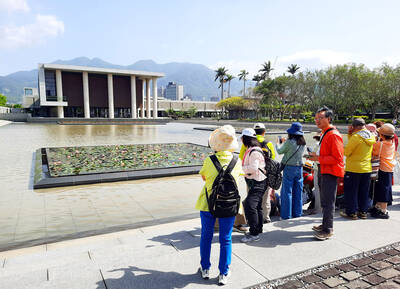
Dull functional structures dominate Taiwan’s cityscapes. But that’s slowly changing, thanks to talented architects and patrons with deep pockets. Since the start of the 21st century, the country has gained several alluring landmark buildings, including the two described below. NUNG CHAN MONASTERY Dharma Drum Mountain (法鼓山, DDM) is one of Taiwan’s most prominent religious organizations. Under the leadership of Buddhist Master Sheng Yen (聖嚴), who died in 2009, it developed into an international Buddhist foundation active in the spiritual, cultural and educational spheres. Since 2005, DDM’s principal base has been its sprawling hillside complex in New Taipei City’s Jinshan District (金山). But